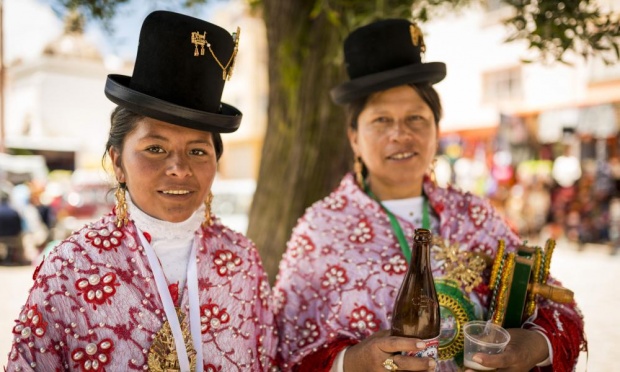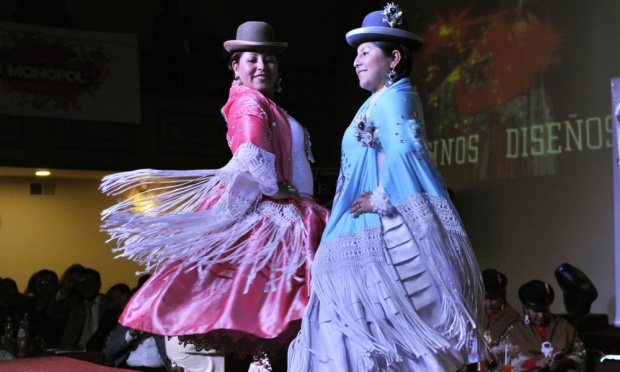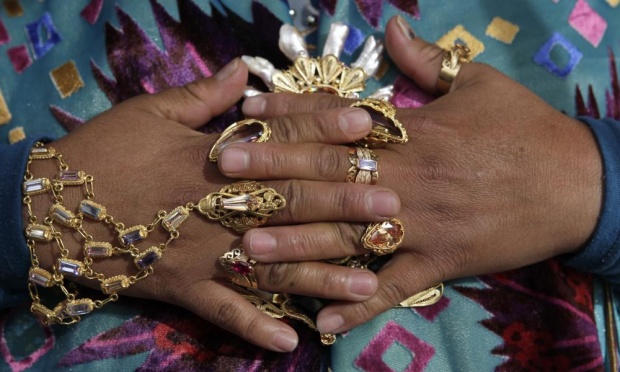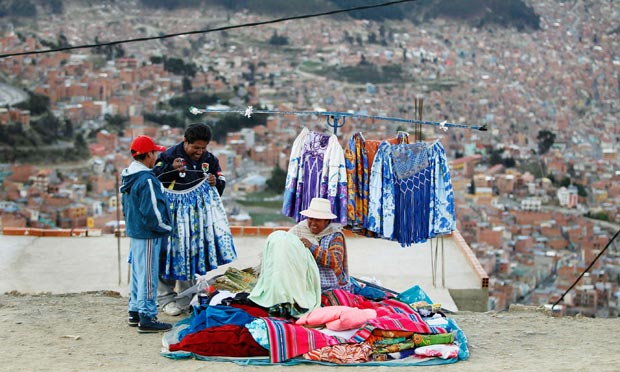
(above) Aymara women of Bolivia show off their newfound upward mobility while preserving their traditional dress of full colourful petticoats and tall bowler hats
Cholitas paceñas: Bolivia's indigenous women flaunt their ethnic pride
April 22, 2015 - theguardian.com
Aymara Indian women known as cholitas paceñas wear their traditional dress, which includes patterned shawls and bowler hats. Photograph: Robert Harding/Rex Shutterstock
by Sara Shahriari in La Paz
Brilliantly coloured skirts and fringed shawls swirl and massive gold earrings and brooches glitter as young women sway up and down a room in a 17th century hotel in downtown La Paz.
It's Saturday afternoon, and modelling class is in session. But these are not size-zero supermodels wearing the latest European couture; they are petite indigenous women dressed in rakishly tilted bowler hats, shawls – and layers and layers of petticoats and skirts.
They are dressed in the traditional costume of the Aymara Indian women of La Paz – known as cholitas paceñas – an outfit which once which denoted membership of a marginalised and downtrodden section of Bolivian society, but now reflects the growing confidence and spending power of the country's emergent indigenous middle class.
The modelling school's director, Rosario Aguilar Rodríguez, is a lawyer and local politician who says she is proud to wear the pleated skirt known as the pollera. She also points out that cholita style is a sound investment
(below) Bolivian models walk the catwalk wearing pleated skirts known as pollera. Photograph: Aizar Raldes/AFP/Getty Images

"The strongest market is in women who wear the pollera. They have the economic resources to buy a good mattress, good perfume, good furniture. So betting on indigenous and mestiza women as models means reaching a very important group," she said
(below) reference to an earlier article
Bolivia's protest centre becomes its boomtown Mass migration and investment have helped turn El Alto into a symbol of Bolivia's growing economy and entrepreneurial spirit (below) An Aymara woman sells clothes in the market of El Alto on the outskirts of La Paz, Bolivia. Photograph: Enrique Castro-Mendivil/Reuters by Sara Shahriari in El Alto At a crowded food court in the Bolivian city of El Alto, diners are tucking into plates of burgers, pizzas, fried chicken and Chinese food. It's a simple setup: a dozen restaurants, and a tiled eating area with metal chairs, but prices are comparable with those in the country's de facto capital, La Paz – and every table is full. Until recently, fast-food courts, highrise apartment blocks, shopping malls and new cinemas seemed a world away from this gritty, and occasionally volatile, city. But a string of multimillion-dollar developments have been planned that would have been unthinkable a few years ago. Nearly a decade ago, El Alto exploded into a series of protests and violent clashes with the armed forces over gas exports that left more than 60 people dead and ultimately toppled a president. The city is still a centre for protests and politics that can influence national policy (a popular rallying cry is "El Alto on its feet, never on its knees") but today it's also a symbol of Bolivia's growing economy and entrepreneurial spirit. "In El Alto the climate, the altitude, the lack of water are all issues, but people have overcome those problems by putting double the usual effort," said Edgar Patana Ticona, the city's mayor. "People are extremely hardworking." Ticona, looking freshly pressed and cheerful at 8am, is an example of that ethic: he was in meetings until 5am. Bolivia is one of South America's poorest countries, where huge amounts of valuable raw materials such as silver, tin and gas were historically exported while the local people remained in poverty. But it has seen a period of relative stability and growth since the election in 2006 of President Evo Morales, the polarising former coca farmer and leader of the Movement Toward Socialism (MAS). Today, Morales is the longest-serving leader since the country returned to democracy 30 years ago. Average yearly economic growth has been 4.7% over the past five years, according to the World Bank, outstripping the figures for countries such as the UK, the US and Germany. Morales nationalised the country's gas industry, and steadily high prices for hydrocarbons and minerals, Bolivia's two key exports, have been a boon to the national economy and supported some of the government's poverty reduction programmes. El Alto is one of the most dramatic examples of Bolivian growth. During the past decade mass migration from rural indigenous communities jump-started a commercial and construction boom. Between 2006 and 2011 the number of construction companies registered in El Alto grew by more than 200%, and manufacturing more than doubled, according to Bolivia's business registry The city's vast commercial power is most evident at its twice-weekly open-air market, where Aymara Indian women in bowler hats and multicoloured skirts buoyed by white petticoats sail down crowded streets where everything from gold jewellery to cars to donkeys is for sale. Many of El Alto's businessmen and women preside over small businesses, and the informal economy is a huge force. Big investments are also arriving. Alejandro Yaffar de la Barra is president of DYA SRL, the company behind a recently built modern food court in El Alto. It's something that didn't exist here before, and business is going well. "El Alto is a city that's poised to grow economically and commercially," he said. With more large-scale projects planned, Ticona expects El Alto's transformation to continue over the next decade. But it's not all roses. Poverty is still widespread, and El Alto's tax revenues are so small that the city relies heavily on central government to support infrastructure projects from paved roads to sewers, which always seem lag behind the needs of the ever-growing population. On the national level, poverty is falling but remains a serious issue, and some economists say that if mineral and gas prices fall, Bolivia will be left in the economic lurch. Still, many people are hopeful. Nelson David Chambi owns a textile business in El Alto that makes quilts and sheets from imported fabric. Chambi's business has taken him to the very different landscapes of huge cities in China and Brazil. He hopes that everything from the water and sewer service to the mass transport and commercial centres enjoyed by residents there will become reality here during the next few years. Asked if that seems likely, he chuckles. "As the saying goes," he said, "a man without imagination is a man without wings." |
Bolivia is still one of Latin America's poorest countries, but its economy has grown rapidly in recent years on the back of high mineral and gas prices, and the government's pragmatic economic policies. That growth has helped a commercial boom in La Paz and the neighbouring city of El Alto, where Aymara merchants – many of them women – play important and lucrative role.
Nilda Virginia Gutierrez is a merchant and fashion designer, whose small store in La Paz is packed floor to ceiling with a rainbow-array of skirts and shawls. "We bring out new fashion every month," she says. "We are always innovating, because there's so much competition."
Even the unpracticed eye can see that this fashion is not static. The crowns of the bowler hats that perch atop a cholita's glossy black braids are getting lower and lower; high crowns now look very last year.
"Now people are spending more - people want a whole outfit, from the jewellery to the shoes to the hat," said Gutierrez.
(below) Casilda Paco shows off her hand jewellery. Photograph: David Mercado/Reuters/Corbis
None of that comes cheap: a Borsalino – the most famous brand of bowler hat – costs roughly 300 pounds, and a standard outfit commonly costs another 300. No outfit is complete without earrings and a sparkling brooch to fasten the shawl and another adorning the hat. A fine set may run around 1,400 pounds - but the best can be well over 6,000.
These extraordinary ensembles are shown off at events like weddings, or La Paz's yearly Gran Poder festival, which brings the cities' wealthy Aymara merchants out in force. Some of the jewels women wear in Gran Poder are so pricey that they reportedly employ bodyguards follow them throughout the day.
This increased visibility is more than an exercise in conspicuous consumption: forced into servitude under colonial rule and later relegated to the margins of society, Bolivia's many indigenous peoples were long excluded from mainstream society. Until the 1990s, wearing a pollera or a poncho to a government office would have been unthinkable.
But attitudes started to change with the election Evo Morales, the country's first indigenous president who took office in 2006.
"Before even recognizing oneself as Aymara was difficult. Really the reverse was happening – because the less Aymara you were, the more social mobility you had. Today it's very different," said sociologist Germán Guaygua, who works at the ministry of foreign affairs.
Model and TV personality Maria Elena Condori Salgado embodies both the entrepreneurial spirit and ethnic pride of this new Aymara identity. "I've worn the pollera since I was very small. My mother wears the pollera, and so did my grandmother," she said.
"For us this is an art," Condori Salgado said of her clothes and the message they send to the world. "We are going to conserve it – at least I'm not going to change."
